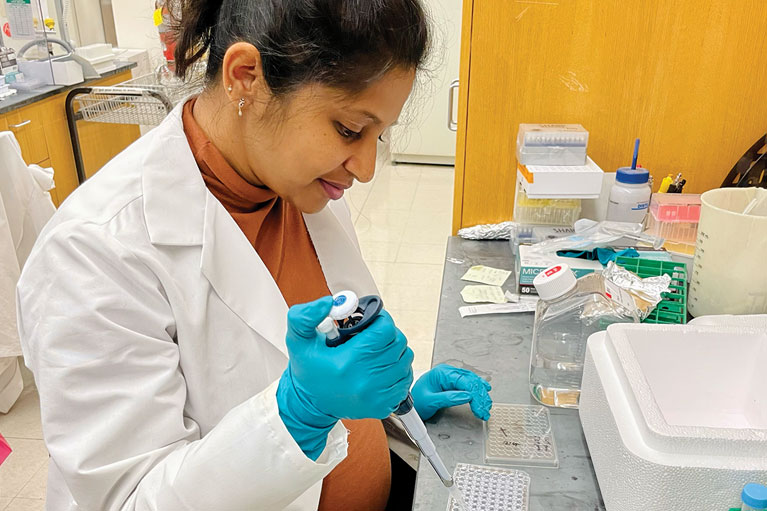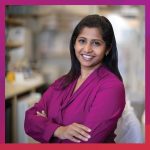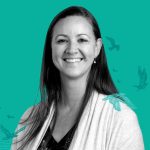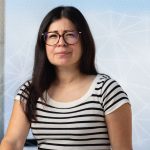Observations Deepshika Ramanan From iguana poop to breastmilk
When Assistant Professor Deepshika Ramanan was a child growing up near the forests of South India, she and her siblings would accompany their photographer father on nature shoots. The siblings were all thrilled whenever they were chased by wild elephants—something their homemaker mother also took in stride, since this was a common occurrence in the region.
Inside Salk sat down with the new assistant professor for some answers on what motivates her powerful drive to discover.
At Salk, Ramanan is a member of the NOMIS Center for Immunobiology and Microbial Pathogenesis. She studies maternal-infant immunity: specifically, how the immune system develops in babies—influenced by factors in breastmilk—as well as how a pregnant person’s immune system changes during pregnancy and breastfeeding.
Both of these areas are poorly understood, and Ramanan has many, many questions.
You became interested in biology fairly early in life. Can you tell us more about that?
DR: I was always a curious child, and because of my dad’s love for wildlife, we spent a lot of time in the forest. So I had always gravitated toward nature. Then, in sixth grade, I had a biology teacher who I really connected with. I already loved nature and wildlife, but she really strengthened my love for biology.
This was pretty important, because no one in my family had any experience in science or medicine. My father went to technical school and my mother didn’t finish high school. None of us knew any scientists. Even my biology teacher didn’t mention being a scientist as an option for me. A female scientist was just a very far-fetched idea where I’m from. Luckily, my parents supported me by helping me to leave home and make my own path.
How did your interest in the biology of disease come about?
DR: When I was in 7th grade, my grandmom passed away. She’d had diabetes and couldn’t walk because of nerve damage. When I was young, I didn’t quite understand her illness. People said, “This is how God wants it.” But it just didn’t make sense to me that God would want someone to suffer like that. I thought, “Well, that can’t be the reason.” So I started reading more and more about biology and health, and I got really into learning about diseases and the idea of doing research.
You did some unusual research as an undergraduate in Minnesota—can you describe that?
DR: I got my degree in cell and molecular Biology from Winona State University, but I was very interested in microbiology. We had iguanas in our biology labs there, and my microbiology professor introduced us to the concept of the microbiome and offered me a project to look at, well, their poop! I was looking to see how many different kinds of bacteria I could grow from the iguanas, so I could characterize their microbiomes. It involved collecting fecal samples and sequencing them. Interestingly, we grew a lot of the same kind of bacteria that we can grow from people.
How did you go from studying iguana poop as an undergraduate to studying the immune system in graduate school?
DE: When I was in college, I did an internship at the Mayo Clinic in Rochester, Minnesota. I trained in an immunology lab, which was my introduction to immunology. I was working with the thymus, the butterfly-shaped gland where your immune cells get “educated.” I thought it was just fascinating. So when I applied to graduate schools, I was interested in both immunology and microbiology.
I ended up going to New York University, where I met my PhD mentor, Ken Cadwell, during a poster session. In his lab, the team was looking at immune cells in response to the microbiome, and I was instantly hooked. I loved immunology from my internship. I loved microbiology from my undergrad experience. I thought, “This is the lab that I want to be in, because it’s bringing together two branches of science that I love.” So I joined his lab as his first student, and worked on setting up a mouse model of intestinal inflammation in inflammatory bowel disease (IBD).
It’s interesting—not a lot of people who have the gene mutation that makes you susceptible to developing IBD get the disease, which suggests that, in addition to genetics, a person’s environment also influences risk for IBD.
So we used mice that have the same mutation that a lot of people with IBD have, and I found that the intestine of these mice had inflammatory microbiota that made them more likely to have the type of inflammation seen in IBD. Surprisingly, if we gave these mice parasites, they promoted a protective microbiota and got rid of the disease-causing microbes, and the mice no longer had the disease. We also translated our findings to humans, and we found that people who lived in regions where parasite infections were common also had a protective microbiota, and people with IBD had inflammatory microbiota similar to what we had found in mice. To me, as a graduate student, that was just amazing.
What did you study for your postdoctoral fellowship?
DR: For my PhD, I worked on the microbial aspect of intestinal disease, but I was also really fascinated by the intestine and wanted to focus more on the immune aspect of it in the next phase of my training. So I joined the lab of Diane Mathis and Christophe Benoist at Harvard Medical School. They are experts in a type of immune cell that suppresses inflammation, called a regulatory T cell, or Treg.
When you get infected with some type of bug, you’re going to have a lot of inflammation as part of your body’s immune response to clear the infection. But how does your body know when it’s time to stop fighting? It turns out Tregs tell the infection-fighting immune cells to stop. They’re sort of like immune police.
At Harvard, I began working on Tregs that were responding to the microbes in the intestine, trying to understand how they maintain tolerance to the microbes in the intestine so that you don’t react to all the beneficial microbes that you have living in your guts. But while I was trying to figure out their function, I serendipitously ended up making a surprising discovery—that the intestinal Tregs in mice were determined by their mothers! Long story short, mothers transfer antibodies in their milk that form a coating around microbes in mouse babies’ intestines. And this coating determines the levels of Tregs the mice will have in their intestines, not just as babies, but also as adults!

“It just blows my mind that milk is literally the first food we get as humans, and we know barely anything about it.”
–Assistant Professor Deepshika Ramanan
So did that discovery kindle your interest in breastmilk?
DR: It did! I have so many questions! What my lab at Salk is working on now is trying to understand the mechanism of how and when this breastmilk immunity is happening. How do the antibodies that are in breast milk educate the immune system? Are they just educating immune cells in the intestine, or are they educating other cells in the intestine that then tell the immune cells what to do? How are these antibodies shaping the microbes? What is the antibody coating doing to the microbes?
It just blows my mind that milk is literally the first food we get as humans, and we know barely anything about it.
You sound quite impassioned about that.
DR: I am. A lot of what my lab studies was inspired by my own personal journey while pregnant and breastfeeding, and I was surprised we knew so little about the immune system during these critical times. I think that’s one reason why we need diversity in science and why we need to have people of different backgrounds and different experiences, so entire groups of people don’t get left out.
Our lab is also very interested in looking at what’s happening to the mothers themselves during pregnancy and lactation. Because, while we don’t know much about what’s in the milk, we also don’t know anything about what happens to the mammary gland during pregnancy and breastfeeding, in terms of immunity.
For example, pregnant people are somewhat immunosuppressed. Their blood and uteruses are immunosuppressed, yet during pregnancy and lactation, we see the opposite in the mammary gland—there is a lot of immune-cell activation. We’re trying to find out why that’s happening. It is known that people who breastfeed are less likely to develop breast, ovarian, and uterine cancers, but we don’t know why. Our studies could offer an explanation for this, which can help us prevent or treat these cancers in the future.
I’m also excited that I’ll be partnering with the Human Milk Institute at UC San Diego, which is the largest repository of breastmilk in the country. We’re going to be looking at the composition of the antibodies in milk. Antibodies are just one part of milk, obviously; there are a ton of other factors in milk as well. So we’re interested in also looking at what other factors could be shaping the immune system of offspring. Another benefit is that if scientists know what the components of breast milk are, then formula makers can find ways to design better formula, because not everyone can breastfeed.
You arrived at Salk in the spring of 2023. How has your experience been so far?
DR: It’s been incredible. When I first came to interview, everybody was so friendly, excited to have me, and asked me such great questions. During my chalk talk, faculty who were not even in my field were asking me insightful questions and offering me ideas on ways to make my science better, which felt amazing. I thought, “What better environment is there than this? Everybody’s so supportive. Everybody’s genuinely interested in science. It doesn’t matter what area of science, people are just genuinely curious, like me.” I called my husband right afterward and told him that Salk was my top choice of institutions. My first impression could not have been truer.
I’m excited to be at Salk and to work with the entire scientific community here. I have also been fortunate to recruit an amazing team in the short amount of time I have been here, and together, I’m sure we are going to discover exciting things. I’m looking forward to it.
Support a legacy where cures begin.
Featured Stories
 Deepshika Ramanan–From iguana poop to breastmilkRamanan, a new assistant professor and microbiologist by training, made a chance discovery about animal gut bacteria that led to her fascination with breastmilk immunity.
Deepshika Ramanan–From iguana poop to breastmilkRamanan, a new assistant professor and microbiologist by training, made a chance discovery about animal gut bacteria that led to her fascination with breastmilk immunity. New strategic plan provides roadmap for enhancing diversity, equity, inclusion, and belonging at SalkGroundbreaking scientific discoveries require talented people behind the scenes, and the more diverse those people are, the more groundbreaking their discoveries. At Salk, improving diversity, equity, and inclusion is a commitment to both scientific discovery and humanity.
New strategic plan provides roadmap for enhancing diversity, equity, inclusion, and belonging at SalkGroundbreaking scientific discoveries require talented people behind the scenes, and the more diverse those people are, the more groundbreaking their discoveries. At Salk, improving diversity, equity, and inclusion is a commitment to both scientific discovery and humanity. Trinka Adamson–Supporting Salk science through animal careAdamson, senior director of Salk’s Animal Resources Department, works to provide the highest quality veterinary medical care, husbandry, enrichment, and professional technical support to enable our scientists to conduct their animal research and make their bold discoveries.
Trinka Adamson–Supporting Salk science through animal careAdamson, senior director of Salk’s Animal Resources Department, works to provide the highest quality veterinary medical care, husbandry, enrichment, and professional technical support to enable our scientists to conduct their animal research and make their bold discoveries. Melissa Hernandez–Horses, hot sauce, and human brain researchHernandez, a postdoctoral researcher in the lab of Professor Rusty Gage, journeyed up and down the west coast and turned from scientist to hot sauce entrepreneur and back before finally settling at Salk to study neuroscience.
Melissa Hernandez–Horses, hot sauce, and human brain researchHernandez, a postdoctoral researcher in the lab of Professor Rusty Gage, journeyed up and down the west coast and turned from scientist to hot sauce entrepreneur and back before finally settling at Salk to study neuroscience. To inspire and educate: Salk’s Education Outreach is on a missionMotivated by Jonas Salk’s admonition to “be good ancestors,” Education Outreach strives to inspire the next generation of scientists. By running programs like the Mobile Science Lab or High School Science Day among others, Education Outreach encourages scientific literacy, enthusiasm in science as a career, and awareness of the value of basic research.
To inspire and educate: Salk’s Education Outreach is on a missionMotivated by Jonas Salk’s admonition to “be good ancestors,” Education Outreach strives to inspire the next generation of scientists. By running programs like the Mobile Science Lab or High School Science Day among others, Education Outreach encourages scientific literacy, enthusiasm in science as a career, and awareness of the value of basic research.




















































